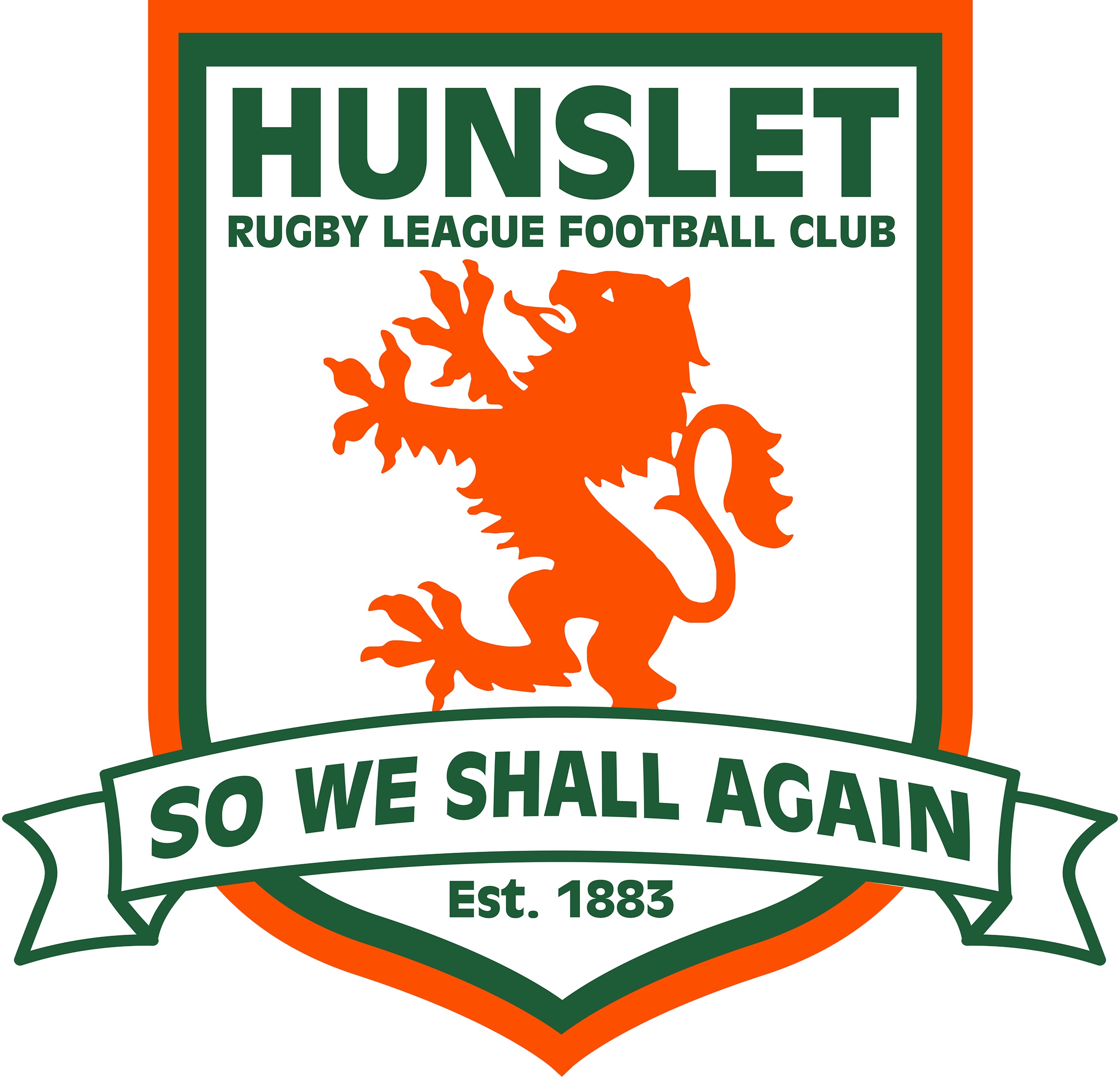Prior to 1900, when there was a football boom spreading throughout England, Leeds was more of a “rugby” city. To host this game in the winter, the rugby football clubs were set up as part of cricket clubs, and as a result the cricket grounds were used to play this new game. The Hunslet club was part of the Hunslet cricket club.The Hunslet cricket club wanted to protect their playing surface, so as a result in May of 1883 two of the local teams, Albion and Excelsior, were granted the sum of £30 to form the Hunslet Rugby Club. At the end of that year the Imperial side joined the Hunslet club. Hunslet announced their arrival the following season by beating Leeds St Johns (who later became Leeds R.L.F.C) in the 3rd round of the Yorkshire cup. Better fixtures drew larger crowds and as a result the landlord at Hunslet’s ground Mr Cusworth of the “Cemetery Tavern” wanted to put up the rent. But the two parties couldn’t agree a fee so the search was on for another ground.
The search took the Hunslet club to a piece of land that was owned by the Low Moor Iron and Coal Company at Hunslet Carr, called Low Moor. After clearing some 2000 tons of rubble from the site, laying a playing surface and re-erecting the old stand from Woodhouse Hill, Hunslet were now ready to play their first game at the new ground – Parkside. The first game was played in February 1888. Just one season after the move to Parkside, Hunslet won a trophy for the first time. The Yorkshire Cup was won by beating Leeds St Johns.
The facilities may not have been the best at Parkside, but Hunslet started to attract, and maintained, a good level of support. That support was nearly the downfall of the club. It came after a cup tie against Brighouse Rangers in April 1895. 21 police officers had to rescue a match official from a section of the crowd after the defeat. Because of this the governing body of the sport in the region – the Yorkshire Rugby Union – closed Parkside until November that year. The ban was never fully imposed as later in 1895 Hunslet were one of the 21 clubs that broke away from the Rugby Football Union, and joined the Northern Football Union (this later became the Rugby Football League). The closure of Parkside lasted until September and Hunslet lost the first game away to Warrington. A week later rugby returned to Parkside and 6,000 people turned out to see Hunslet defeat Oldham.
In the 1905-06 season Hunslet tasted success again, winning the Northern Union Yorkshire Cup. This was only a taster of what was to come. When the Northern Union first broke away from the RFU the game was still being played under the same rules, but unlike the old regime,the northern Union was more open to changing the rules to help make the game more appealing to the spectators. One of the biggest changes that set the Northern Union apart from the Southern based Rugby Football Union was the reduction in players from 15 to 13 in 1906. Hunslet seemed to profit almost immediately from the reduction in players, as in 1907-08 Hunslet won all 4 cups that were available for the club to win. The trophies that Hunslet won in 1907-08 were – the Yorkshire Cup, the Yorkshire League Trophy, the Challenge Cup and the Championship Trophy. Unfortunately following this success many players left Parkside either being transferred to other clubs or going into retirement.
In the remaining years up to the 1930’s, Hunslet had rather a lean period, until 1932 when Hunslet regained the Yorkshire League Trophy and also got to the final of the Yorkshire cup. Hunslet celebrated its 50th anniversary in 1933/34. The club did this in some style as Hunslet beat Widnes at Wembley in the Cup Final. Hunslet tasted success 4 years later at Elland Road by beating Leeds in the Championship Final. This wave of success was only halted by the Second World War.
After the war Hunslet tried to keep the success going where it had left off but never quite got there despite reaching a number of semi-finals and finals. Despite this, Hunslet did produce a number of international players as well as a respectable league record. The club had always had strength in the local talent and the supply seemed endless. This local talent was blended, with some success, with both Welsh and Australian imports.
In the 1960’s the club could be best described as the classic under-achievers. Although the players were a group of experienced and talented people they were unable to harness their skills to best effect. This situation changed when the club appointed Fred Ward player coach at the start of the 1962/63 season. Within 3 years of his appointment, Hunslet had won and secured their position in the top division, appeared in two Yorkshire Cup finals and in 1965 took part in one of the best ever Challenge Cup finals, losing narrowly to Wigan. Unfortunately after this event, as in 1908, the side split up. 5 players were moved onto other clubs and 4 senior players retired. Just 2 years later in 1967 the dream was over. Ward left the club, and with that the club entered free fall. The ground was sold in 1972 and by July the following year the secretary, Mr M Plenderleigh, announced the winding up of the club.
After the doom of July 1973, the white knight appeared in the shape of Geoff Gunney, who ended his playing career in the last game at Parkside against York and was the last player to leave the field of play. The club then moved to the Greyhound Stadium on Elland Road. As things improved, the floodlights at the ground gave Hunslet the chance to score 1 or 2 notable victories. But the stay at the Greyhound Stadium was cut short when the owners closed the ground, which is now just car parking for the Leeds United football ground further down the road.
The next ground to host Hunslet was Batley, before Hunslet moved back to Elland Road, this time at the football ground after it was taken over by the local council. The relationship with Leeds Utd was never brilliant, especially when United lost, due to some problems with the playing surface. But when Hunslet played at Elland Road it led to the venue regularly holding big Rugby League matches. After leaving Elland Road, Hunslet had a brief spell at Bramley before moving back “home”. In 1995 the club, now known as Hunslet Hawks, moved into a purpose built complex in South Leeds. The South Leeds Stadium is just a long drop kick away from where the old Parkside ground once stood.
On 19th November 1995 Hunslet finally came home, playing their first game back in South Leeds for 22 years when Leigh Centurions were the visitors. Since the Hawks moved back home they narrowly missed out on promotion in 1996. In 1997 the Hawks appeared at Wembley for the first time since 1965 in the first (and last) Challenge Cup Plate Final, defeated by Hull KR. Also in that year the Hawks were promoted to the 1st division. In 1999 Hunslet finally acheived their main aim, and won the NFP Grand final against Dewsbury 12-11 at Headingley. This victory should have heralded the dawn of a new era for the club in Super League, but unfortunately the RL denied them their rightful place with the games elite. This decision proved catastrophic for the club as players, supporters and sponsors all lost heart and decided to jump ship. The club has struggled to stay afloat ever since and is still hanging on by its finger tips to its status as a member of the Rugby League family. The club’s struggles finally led to an emergency meeting at the Stadium in November 2007.
New Chairman Stephen Ball outlined proposals to try and save the club from going under, and efforts are currently being made to somehow stabilize the club and move it forward in 2008. These included the introduction of Graeme Hallas as Head Coach to replace the out going Mark Cass. Many of the club’s players left at the end of 2007 and Graeme Hallas had to start more or less with a blank page. Many young recruits were introduced, along with some older more experienced players to steady the ship. The immediate future looked extremely difficult but long term stability should be achieved. Pre match entertainment was also introduced with singers Kelly Richardson and cult hero and ex-Hunslet stalwart “Stevo” Pryce. The Myrtle and Flame club was launched with around 130 supporters agreeing to pay £5 per week to help the club in its hour of need. The future of the club, although gloomy short-term, seemed to be looking OK for the forseeable future, and the threat of closure had once again passed. There remained much hard work to be done, but if the stay away fans could be tempted back then a return to former glories was once again a distinct possibility for the club. The 2008 season was a disaster on the field as the club finished bottom of NL2. However off the field progress was being made to clear the club’s debt, and hopefully provide the club with a solid base from which to build. Prior to the 2009 season several new signings were introduced with the emphasis on local youth. Could there be light at the end of the tunnel ??
Midway through 2009 Paul March arrived as player coach from York and steered the club to a playoff place. With a full pre season under our belts and a host of new signings Hunslet were ready to make a big impact on Championship 1 in 2010. The Hawks started the campaign in great style and went on to sweep all before them in the league, winning Championship 1 and securing promotion to the Championship.
In 2011 the main aim of the club was to retain its status. Paul March and his team put in some great performances which helped the club to avoid relegation by a single point, a great achievement by all involved, the first time a promoted club had gone up and stayed up! Barry Eaton was installed as the clubs full time head coach and for the 2012 season and HIST officialy took ownership of the club in February 2012. The Hawks managed to avoid the dreaded “Wooden Spoon” in 2012 beating arch rivals York in our final game of the season 28-26. 2012 was a tough season on the pitch and 2013 proved to be even tougher as the Hawks were relegated to Championship 1 despite gaining 12 bonus points and 6 wins.
2014 saw the Hawks finish second in the regular league season, but as in 1999 the Hawks then went on to lift the Championship One trophy beating Oldham Roughyeds in the Grand Final 17-16 with Thomas Coyle landing a 68th minute drop goal. The Hawks are now promoted back to the championship, where we will face the likes of Bradford Bulls and London Broncos.


